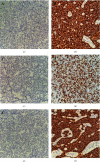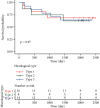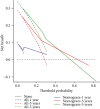Clinicopathological Features and Postoperative Survival Analysis of Gastric Carcinoma with Neuroendocrine Differentiation
- PMID: 36035314
- PMCID: PMC9402359
- DOI: 10.1155/2022/4440098
Clinicopathological Features and Postoperative Survival Analysis of Gastric Carcinoma with Neuroendocrine Differentiation
Abstract
Objectives: This study aims at investigating the differences of clinicopathological features and postoperative prognosis in three different types of neuroendocrine differentiation-related gastric cancers.
Methods: From January 1, 2015 to September 30, 2016, 47 patients diagnosed with neuroendocrine differentiation-related gastric cancers were collected from 1095 patients with gastric cancer who underwent surgical treatment in the Department of Gastrointestinal Surgery, Jiangsu Cancer Hospital. Patients were followed up regularly, and the last follow-up time was October 25, 2021. A total of 38 cases met the inclusion criteria and completed follow-up. The clinicopathological characters and immunohistochemical results of these three special pathological types of gastric cancer (adenocarcinoma with neuroendocrine differentiation, mixed adenoneuroendocrine carcinoma, and neuroendocrine carcinoma of the stomach) patients were compared. Tissues from these patients were tested with immunohistochemical markers synaptophysin (Syn), chromogranin A (CgA), and Ki-67. The Kaplan-Meier method and log-rank test were used to analyze the effect of different histological types of gastric cancer on overall survival (OS). The differences in positive rates of chromogranin A (CgA) and Ki-67 were analyzed by univariate Cox regression analysis as independent risk factors that may affect the survival of gastric cancer patients.
Results: Ki-67 and N staging were significantly correlated with OS in gastric cancer patients and were independent prognostic factors affecting the survival of gastric cancer patients. There was no statistical difference in OS between the two histopathological types (adenocarcinoma with neuroendocrine differentiation and mixed adenoneuroendocrine carcinoma) of gastric cancer patients. There were no significant differences in the positive rates of immunohistochemical markers Syn, CgA, and Ki-67 in gastric cancer patients with different histological types.
Conclusion: The combined detection of Syn and CgA is of great value for the diagnosis of neuroendocrine differentiation-related gastric cancers, Ki-67 is of significance for the prognosis prediction of neuroendocrine differentiation-related gastric cancers, regional lymph node metastasis has a great impact on tumor prognosis, and the N staging determines the necessity of postoperative adjuvant chemotherapy for patients with neuroendocrine differentiation-related gastric cancer.
Copyright © 2022 Jin Liu et al.
Conflict of interest statement
The authors declare that there are no conflicts of interest.
Figures






Similar articles
-
[Clinicopathological features and survival analysis of gastric cancer patients with neuroendocrine differentiation after radical resection].Zhonghua Wei Chang Wai Ke Za Zhi. 2021 May 25;24(5):426-432. doi: 10.3760/cma.j.cn.441530-20201126-00627. Zhonghua Wei Chang Wai Ke Za Zhi. 2021. PMID: 34000772 Chinese.
-
Analysis of Clinicopathological Features and Prognostic Factors in 39 Cases of Bladder Neuroendocrine Carcinoma.Anticancer Res. 2017 Aug;37(8):4529-4537. doi: 10.21873/anticanres.11850. Anticancer Res. 2017. PMID: 28739749
-
[Analysis of clinicopathological features of intestinal neuroendocrine neoplasms].Zhonghua Zhong Liu Za Zhi. 2012 Jun;34(6):450-6. Zhonghua Zhong Liu Za Zhi. 2012. PMID: 22967448 Chinese.
-
[Clinicopathologic features of primary renal neuroendocrine carcinoma].Zhonghua Bing Li Xue Za Zhi. 2018 Nov 8;47(11):851-856. doi: 10.3760/cma.j.issn.0529-5807.2018.11.007. Zhonghua Bing Li Xue Za Zhi. 2018. PMID: 30423609 Review. Chinese.
-
Mixed neuroendocrine-non-neuroendocrine neoplasm of the gallbladder: case report and literature review.Diagn Pathol. 2022 Jun 17;17(1):51. doi: 10.1186/s13000-022-01231-6. Diagn Pathol. 2022. PMID: 35715834 Free PMC article. Review.
Cited by
-
Comparison of proximal and distal gastric neuroendocrine carcinoma based on SEER database.Sci Rep. 2024 Oct 29;14(1):25956. doi: 10.1038/s41598-024-76689-z. Sci Rep. 2024. PMID: 39472636 Free PMC article.
-
Gastric mixed neuroendocrine non-neuroendocrine neoplasms.Front Oncol. 2024 Apr 8;14:1335760. doi: 10.3389/fonc.2024.1335760. eCollection 2024. Front Oncol. 2024. PMID: 38655135 Free PMC article. Review.
-
Survival and Metastatic Lymph Node Patterns in Gastric Carcinoma with Exocrine and Neuroendocrine Components.Ann Surg Oncol. 2025 Jun;32(6):4292-4303. doi: 10.1245/s10434-024-16848-8. Epub 2025 Mar 25. Ann Surg Oncol. 2025. PMID: 40131626
References
LinkOut - more resources
Full Text Sources
Research Materials
Miscellaneous

